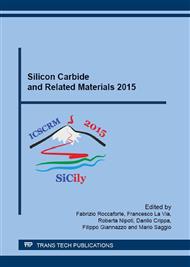p.797
p.803
p.807
p.812
p.817
p.821
p.825
p.829
p.833
Comparative Simulation Study of Dynamic Behavior of the Body-Diode for 4H-SiC JFET and MOSFET
Abstract:
In switching applications with half-bridge like configurations the load current is commutated to the so-called reverse or body-diode of a switching device once each switching cycle. The bipolar charge generated in the switch in principle leads to a reverse recovery current and to additional losses. Though it is well known, that in silicon carbide these reverse recovery losses are very low compared to e.g. silicon devices, it turns out that depending on device structure and switching conditions the reverse recovery charge for the JFET may become larger than can be explainable by the stored bipolar charge. In this paper therefore we focus on a simulation study comparing the body-diode operation of common lateral channel silicon carbide JFET and MOSFET devices in a so-called double pulse measurement. It is shown, that the MOSFET body-diode operation still remains uncritical under very fast switching conditions, while the JFET body-diode exhibits a pronounced recovery current peak originating from a partial channel turn-on, and thus higher losses.
Info:
Periodical:
Pages:
817-820
Citation:
Online since:
May 2016
Authors:
Keywords:
Price:
Сopyright:
© 2016 Trans Tech Publications Ltd. All Rights Reserved
Share:
Citation:


